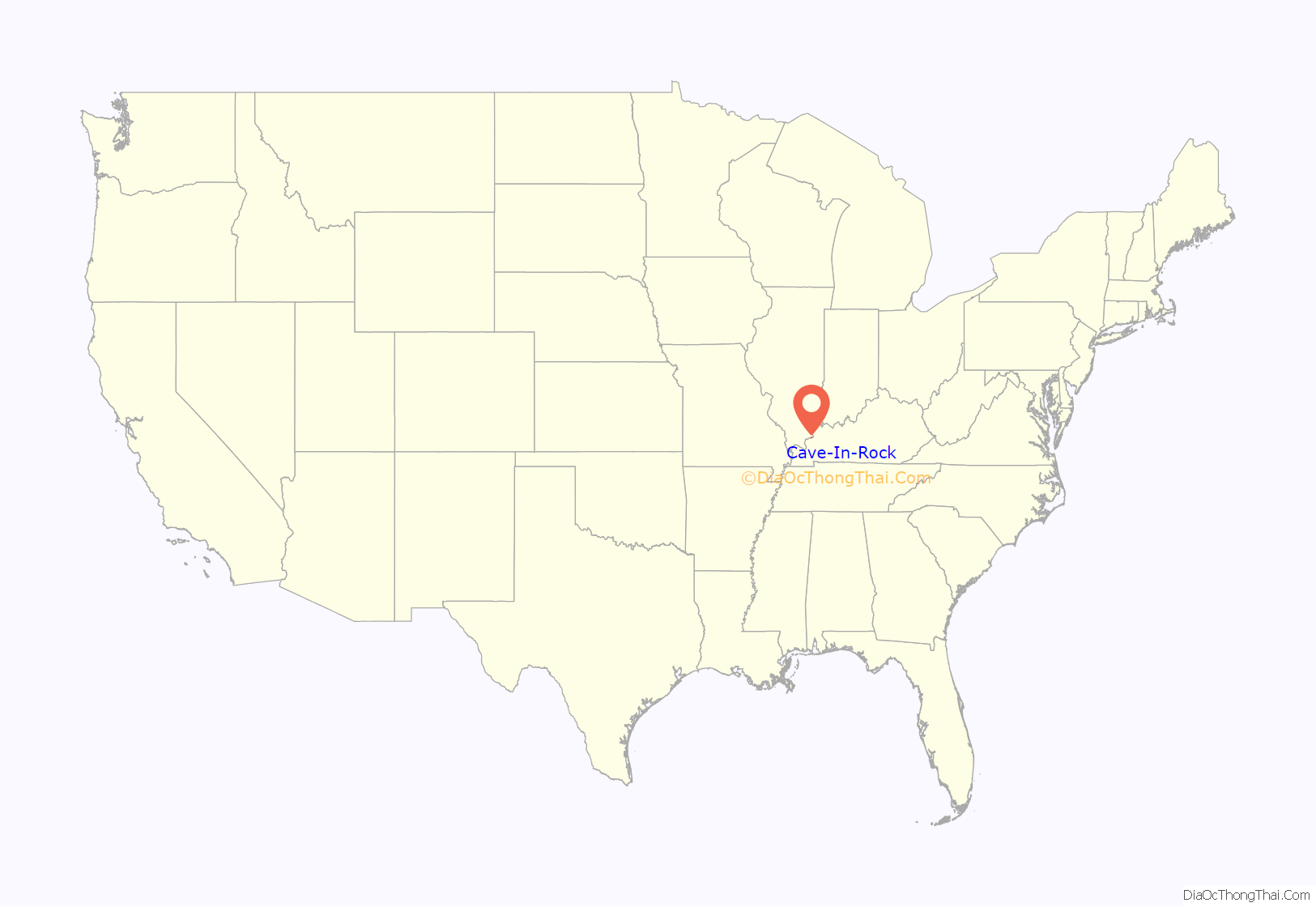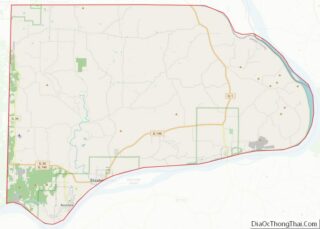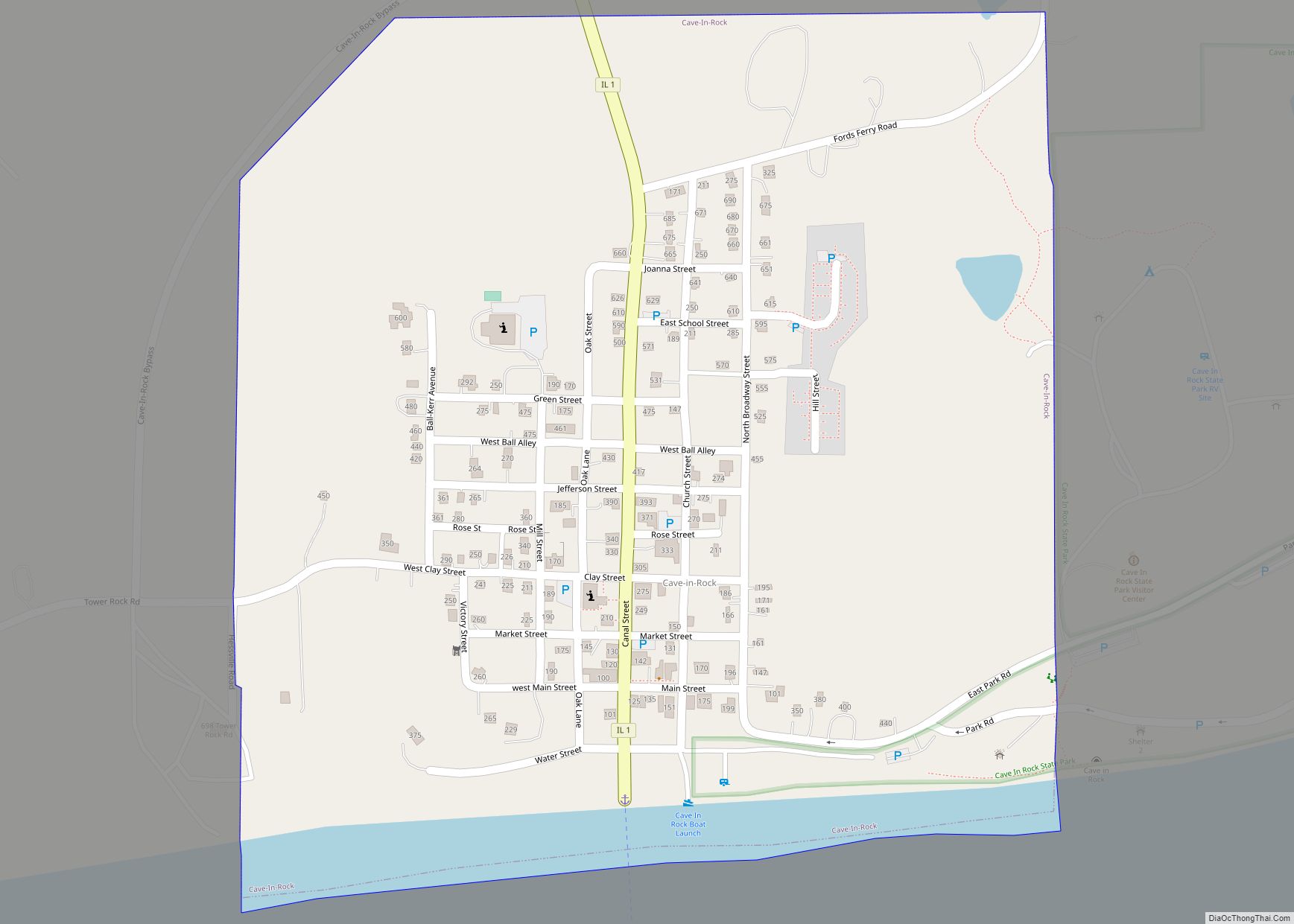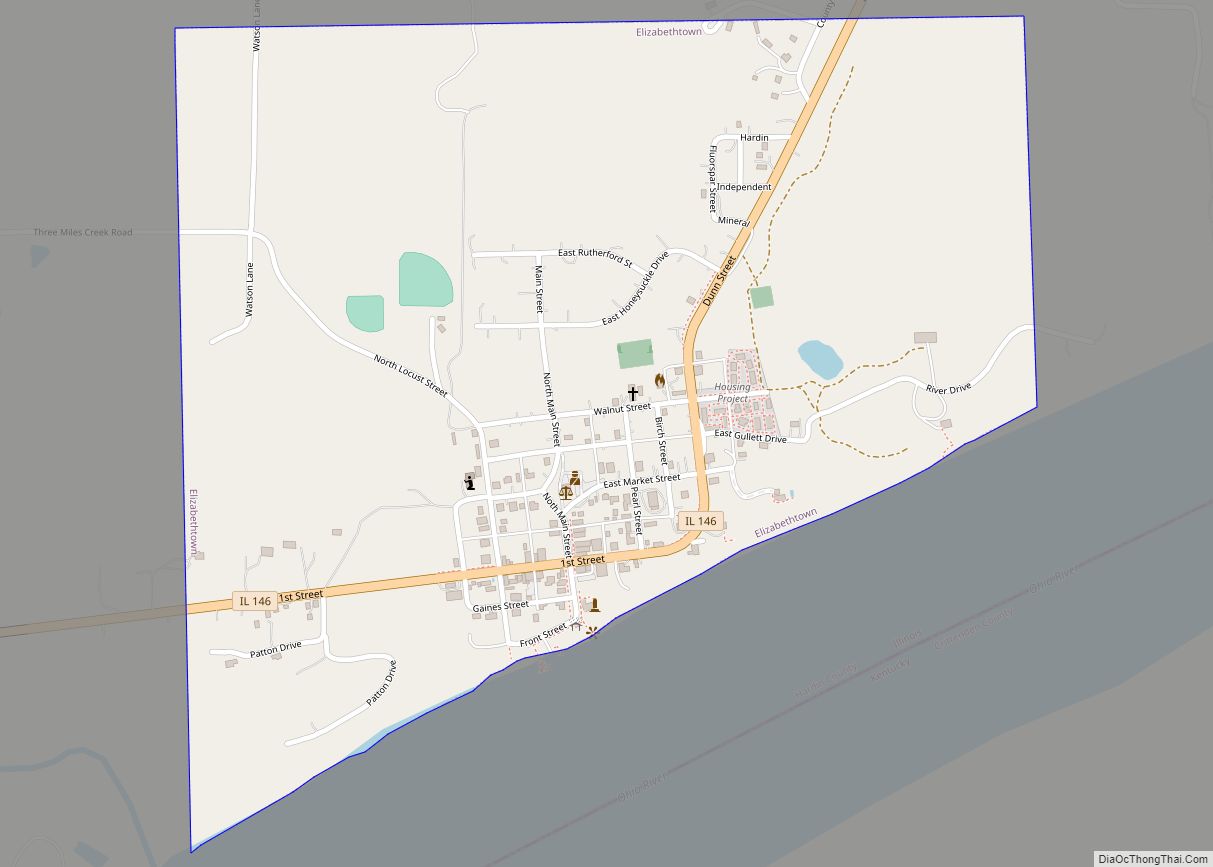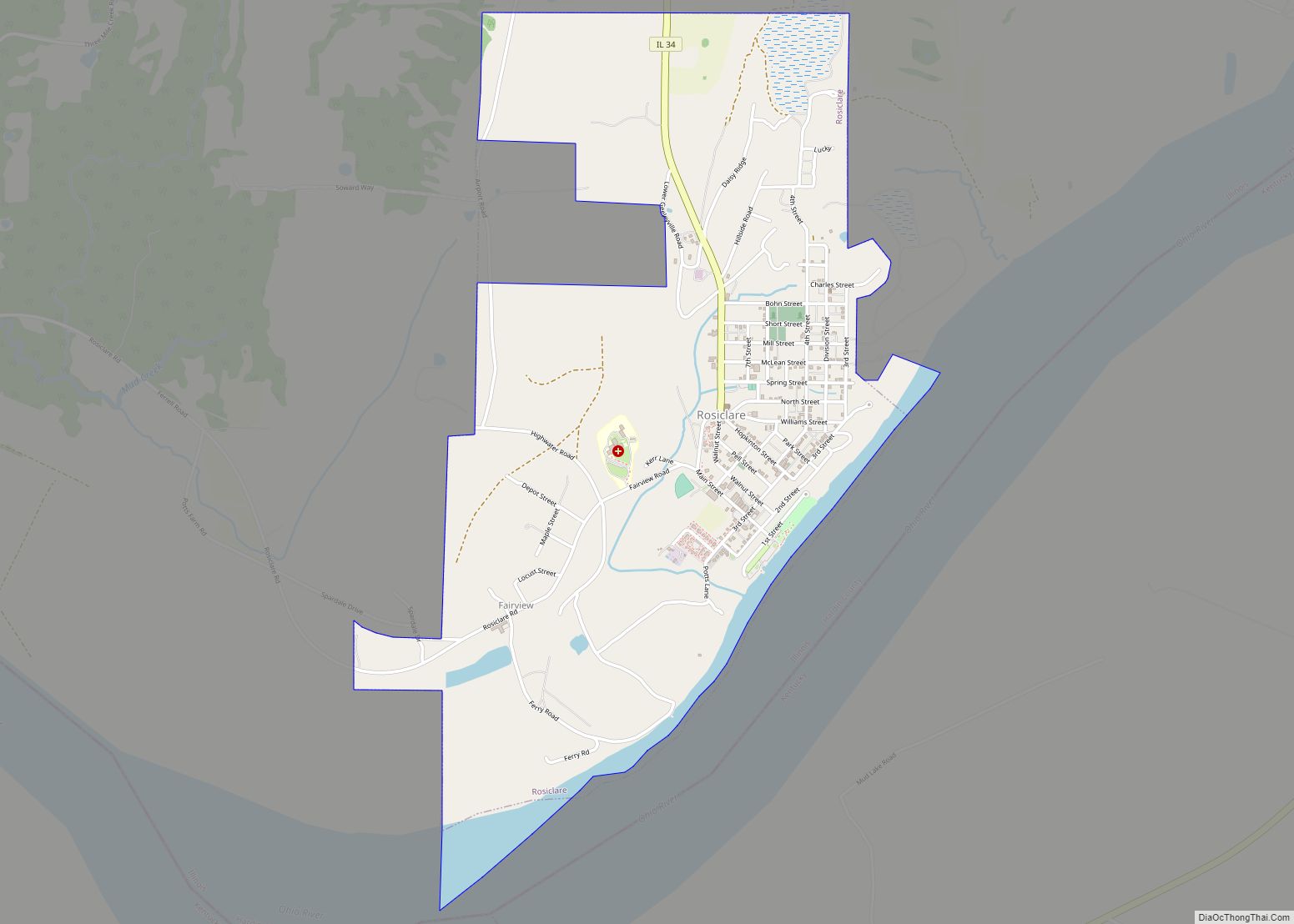Cave-In-Rock is a village in Hardin County, Illinois, United States. Its principal feature and tourist attraction is nearby Cave-In-Rock, on the banks of the Ohio River. In 1816, the earliest known permanent white settlers arrived and started building a town near the cave. The town was originally known as Rock and Cave, Illinois, with a post office under this name. On October 24, 1849, the town was officially renamed Cave-In-Rock. Cave-In-Rock was incorporated as a village in 1901. The population was 318 at the 2010 census.
Beginning in the 1790s, Cave-in-Rock became a refuge stronghold for frontier outlaws, on the run from the law which included river pirates and highwaymen Samuel Mason and James Ford, tavern owner/highwayman Isaiah L. Potts, serial killers/bandits the Harpe brothers, counterfeiters Philip Alston, Peter Alston, John Duff, Eson Bixby, and the Sturdivant Gang, and the post-American Civil War bandit, Logan Belt.
| Name: | Cave-In-Rock village |
|---|---|
| LSAD Code: | 47 |
| LSAD Description: | village (suffix) |
| State: | Illinois |
| County: | Hardin County |
| Elevation: | 390 ft (120 m) |
| Total Area: | 0.41 sq mi (1.07 km²) |
| Land Area: | 0.37 sq mi (0.97 km²) |
| Water Area: | 0.04 sq mi (0.11 km²) |
| Total Population: | 228 |
| Population Density: | 609.63/sq mi (235.65/km²) |
| Area code: | 618 |
| FIPS code: | 1711826 |
| GNISfeature ID: | 2397577 |
Online Interactive Map
Click on ![]() to view map in "full screen" mode.
to view map in "full screen" mode.
Cave-In-Rock location map. Where is Cave-In-Rock village?
History
From the 1790s to the 1870s, the area around Cave-in-Rock was plagued by what historians as early as the 1830s referred to as the “Ancient Colony of Horse-Thieves, Counterfeiters and Robbers”, and better known today due to Otto Rothert’s history early in the 20th century as the “Outlaws of Cave-in-Rock”.
In 1790, counterfeiters Philip Alston and John Duff (or John McElduff) used the cave as some type of rendezvous, though details are scarce. Although folklore printed in 19th century histories failed to establish a prior connection between the two men, both had lived in the area of Natchez, Mississippi, at the start of the Revolutionary War.
Duff was living upriver a few miles, either at Battery Rock or across the Ohio River at what would become Caseyville, Kentucky, when in 1797 Samuel Mason moved his base of operations from Diamond Island and Red Banks to the cave and made it the home of river pirates. Two of Mason’s brothers had been business partners of Duff in Kaskaskia, Illinois, in the 1780s. Mason created a combination tavern, gambling den, brothel, and criminal refuge. His men lured in gullible river travelers and then robbed and killed them.
James Wilson, also known as Bully Wilson, may actually have been an alias for Samuel Mason, the next leader of the gang after Mason’s hasty departure, or possibly the front man for Mason’s operation. He may be the Wilson who married one of Mason’s nieces. In 1799, he hung a sign over the cave’s entrance saying “Wilson’s Liquor Vault and House for Entertainment”.
By this time, Duff and his associates had been making salt (or looking for silver) in the area around the Illinois Salines along the Saline River in southeastern Illinois. A detachment from the U.S. Army garrison at Fort Massac, down river from Cave-In-Rock, captured him and three of his men, Blakely, Hazle and Hall. The soldiers took their prisoners by boat down the Saline River to the Ohio River, intending to return to the fort. Old histories do not explain why they stopped at the cave. Subsequent events suggest it took place during the spring of 1799, when Wilson was in business, making it a stop for entertainment. Duff and his men escaped and overpowered the soldiers. They tied them up, put them in a boat, and pushed it into the river to float downstream to the fort. On June 4, 1799, the commandant of Fort Massac, Captain Zebulon Pike Sr., father of the future explorer of Pikes Peak, hired a French Canadian coureur de bois and three Shawnee warriors to assassinate Duff, which they did.
The infamous Harpe brothers also reached the cave region in the spring of 1799. They are associated with two separate stories at the cave and one at the infamous Potts Spring area to the north. The first story has them pushing a young couple off the top of the cliff above the cave. They survived. The second was an act of piracy in which only one man survived. Later, he was forced off the cliff as well, this time involving the man being tied down to a horse. Neither survived. The Potts Spring story is recalled as a murder of two or three hunters. This Harpe murder site within twenty years would become the future location of the legendary Potts Inn, which was presumed to be a human death trap for unsuspecting travelers along the Ford’s Ferry High Water Road, an early frontier highway, who wanted to spend the night for food and lodging.
Mason and Wilson’s time at the cave may have come to an end during the summer of 1799, when they were attacked by a group of bounty hunters/vigilantes under the leadership of Captain Young calling themselves “The Exterminators”. No contemporary accounts attest to river pirates occupying the cave in the first decade of the 19th century. The Harpes retreated back into Kentucky, while Mason traveled downriver and began to focus on highway robbery along the Natchez Trace.
The next generation of outlaws in the region sprang either from the Sturdivant Gang, a group of counterfeiters based at Sturdivant Fort, on top of the bluffs overlooking the Ohio River at what is now Rosiclare, Illinois; or the Ford’s Ferry Gang led by James Ford, based a few miles upriver from the cave at what became known as Ford’s Ferry, Kentucky. Law enforcement officials led three raids against Sturdivant Fort in 1822 and 1823. Although it is not clear what happened following the raids, the gang had disappeared from the area by 1830. The Ford’s Ferry Gang was broken up following the mysterious deaths or murders of James Ford’s two sons, followed by his own assassination in 1833.
Even after the death of Ford, outlaws remained. Isaiah L. Potts operated Potts Inn on the Ford’s Ferry High Water Road in Illinois north of the cave. Travelers checked in, but sometimes failed to check out. This presumed frontier hotel was very similar to the Bloody Benders’ Wayside Inn, which appeared fifty years later in Labette County, Kansas. The legend of Billy Potts, the returning son who was murdered unknowingly by his father, likely took place in the months following Ford’s assassination. This tragic story of poetic justice has taken on folklorish proportions. Records show the elder Potts and his wife separated in 1834 or 1835.
Eson Bigsby (the first name sometimes spelled “Eason” or “Enos” and the last name sometimes spelled “Bixby”) took up counterfeiting in Hardin County in the decades following the Sturdivants. His attack on his wife Anna in an effort to find out where her first husband’s money was buried dates to the early 1860s and led to the legends of Anna Bixby, her treasure and her ghost. She survived running off a cliff in the dark. She is the namesake of the Anna Bixby Women’s Center in nearby Harrisburg, Illinois.
Although not completely connected to the “Ancient Colony”, Logan Belt and the Logan Belt Gang terrorized Hardin County in the 1870s and 1880s, until Belt was assassinated.
In the middle of the 1800s, church services were being held in the cave. This earliest Christian congregation eventually formed the Big Creek Baptist Church. Founded in 1807, it was the first church organized in southeastern Illinois. Cave-In-Rock incorporated in 1839, in the same year that Hardin County was created from a section of Pope County.
According to the Illinois Department of Natural Resources, “in 1929, the State of Illinois acquired 64.5 acres (26.1 ha) for a park that since has increased to 204 acres (83 ha). The well-wooded, 60-foot (18 m) hills and the rugged bluffs along the river—commanding expansive views of the famous waterway—became Cave-In-Rock State Park”.
Cave-In-Rock Road Map
Cave-In-Rock city Satellite Map
Geography
Cave-In-Rock is located in southeastern Hardin County at 37°28′12″N 88°9′59″W / 37.47000°N 88.16639°W / 37.47000; -88.16639 (37.470050, -88.166297). It is bordered to the south by the Ohio River, which forms the state boundary with Kentucky. The Cave-In-Rock Ferry crosses the Ohio from Cave-In-Rock village to Crittenden County, Kentucky, at a point 11 miles (18 km) north of Marion. Cave-In-Rock is the southern terminus of Illinois Route 1, which leads north from the ferry 326 miles (525 km) to its northern terminus in Chicago.
According to the 2010 census, Cave-In-Rock has a total area of 0.422 square miles (1.09 km), of which 0.37 square miles (0.96 km) (or 87.68%) is land and 0.052 square miles (0.13 km) (or 12.32%) is water.
See also
Map of Illinois State and its subdivision:- Adams
- Alexander
- Bond
- Boone
- Brown
- Bureau
- Calhoun
- Carroll
- Cass
- Champaign
- Christian
- Clark
- Clay
- Clinton
- Coles
- Cook
- Crawford
- Cumberland
- De Kalb
- De Witt
- Douglas
- Dupage
- Edgar
- Edwards
- Effingham
- Fayette
- Ford
- Franklin
- Fulton
- Gallatin
- Greene
- Grundy
- Hamilton
- Hancock
- Hardin
- Henderson
- Henry
- Iroquois
- Jackson
- Jasper
- Jefferson
- Jersey
- Jo Daviess
- Johnson
- Kane
- Kankakee
- Kendall
- Knox
- La Salle
- Lake
- Lake Michigan
- Lawrence
- Lee
- Livingston
- Logan
- Macon
- Macoupin
- Madison
- Marion
- Marshall
- Mason
- Massac
- McDonough
- McHenry
- McLean
- Menard
- Mercer
- Monroe
- Montgomery
- Morgan
- Moultrie
- Ogle
- Peoria
- Perry
- Piatt
- Pike
- Pope
- Pulaski
- Putnam
- Randolph
- Richland
- Rock Island
- Saint Clair
- Saline
- Sangamon
- Schuyler
- Scott
- Shelby
- Stark
- Stephenson
- Tazewell
- Union
- Vermilion
- Wabash
- Warren
- Washington
- Wayne
- White
- Whiteside
- Will
- Williamson
- Winnebago
- Woodford
- Alabama
- Alaska
- Arizona
- Arkansas
- California
- Colorado
- Connecticut
- Delaware
- District of Columbia
- Florida
- Georgia
- Hawaii
- Idaho
- Illinois
- Indiana
- Iowa
- Kansas
- Kentucky
- Louisiana
- Maine
- Maryland
- Massachusetts
- Michigan
- Minnesota
- Mississippi
- Missouri
- Montana
- Nebraska
- Nevada
- New Hampshire
- New Jersey
- New Mexico
- New York
- North Carolina
- North Dakota
- Ohio
- Oklahoma
- Oregon
- Pennsylvania
- Rhode Island
- South Carolina
- South Dakota
- Tennessee
- Texas
- Utah
- Vermont
- Virginia
- Washington
- West Virginia
- Wisconsin
- Wyoming
